#sage erikson
Text
SPANKING ON TV #8
The Life and Legend of Wyatt Earp—S1, E15 Rich Man’s Son (1955) d. Frank Macdonald
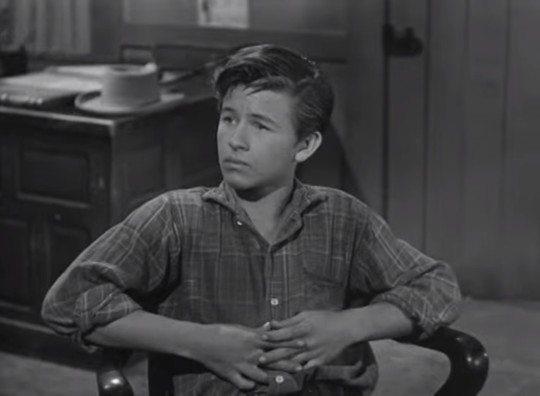
This was one of the first Western TV series to air in the US and one of several that will feature in this blog. The series is loosely based on the life of frontier marshal Wyatt Earp. The half-hour, black-and-white program aired for six seasons from 1955 to 1961, with Hugh O'Brian in the title role.
In contrast to the always-ethical character portrayed in the series, the real-life Wyatt Earp was at various times on either side of the law, having been accused of horse stealing, criminal assault, and involvement with fight-fixing, gambling, prostitution, and murders. If you recognise the name, it’s probably because of his brother, Virgil Earp, of O.K. Corral renown.
In this episode, it’s 1875 and a runaway boy called Timmy Jones shows up in town and refuses to say where he’s from, which means Wyatt can’t send him home as the law requires. Timmy wants to be a gun-toting cowhand, having been enthused by the pop culture literature of the day. Then two railroad detectives turn up and attempt to kidnap him, and it turns out daddy is a rich and powerful railroad executive from New York.
Spoilt, bratty teen-with-attitude being brought to heel by a strong, moral father-figure is a common enough trope, and it’s one that’s frequently mined by the Westerns genre. A bit of sage guidance born of years of experience, coupled with an understanding of the boy’s troubles and some firm discipline, usually involving a spanked or strapped behind, soon fixes said bratty teen (and, it seems, quite a few women in the Wild West) and sets him on the right path to manhood (or motherhood lol).
Young Timmy, played by 14-year-old Lee Erikson, certainly fits the mould of the cute, mid-teen boy running away from his troubles, initially rejecting any help with lots of sass and attitude. No sooner has he crossed paths with our Marshall, though, than he’s being shown the correct way to ride a horse and rope steeds, and finds out that being a cowhand isn’t the exciting, adventurous life he thought it was. One quick, enforced bath and an overdue smacked bottom later, he’s yes sir-ing and asking to be adopted; at one point he even voluntarily bends over to be spanked again when Wyatt thinks he’s lying.
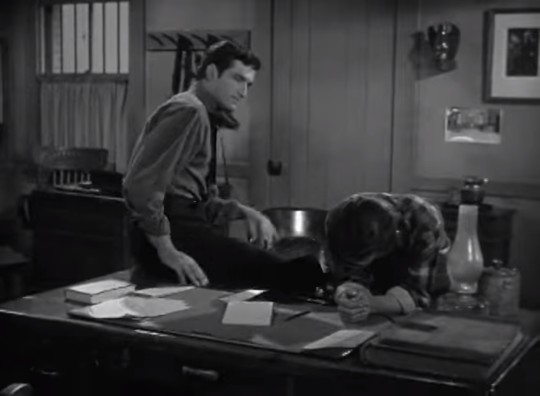
Perhaps there’s a hint of homoeroticism running beneath all the paternalism on display, but maybe that’s just my cynical modern sensibilities. Wyatt certainly seems to manhandle Timmy a lot, though—pulling him around by his collar…

Brushing him down when he gets dusty…

Swatting him encouragingly on the backside…
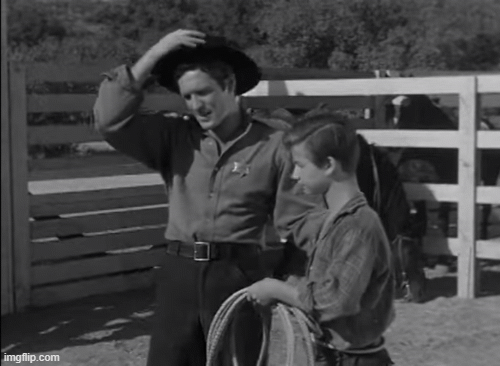
Washing him in a barrel of cold water…
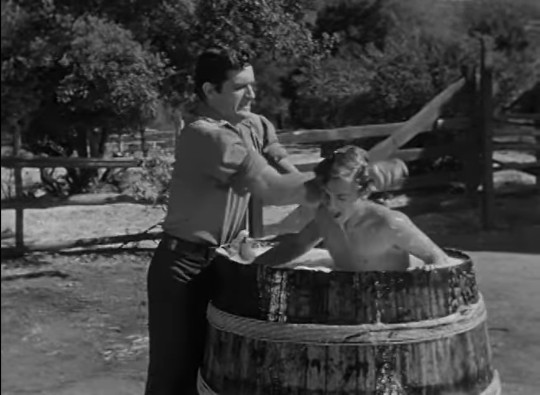
Giving him a spanking…


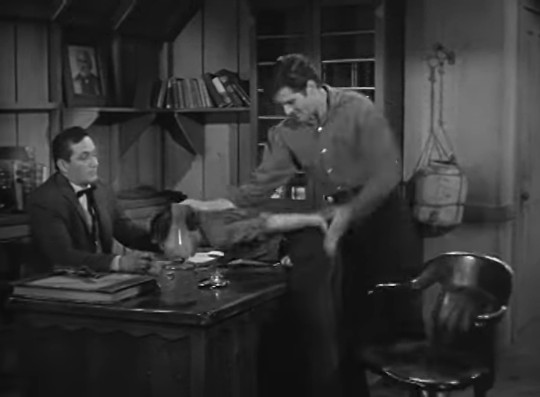


Indeed, the first time they meet Wyatt threatens to spank him (although admittedly Timmy has just tried to shoot him) and then hoists him backwards over a six-foot fence with a hand firmly planted in his groin (although fair play to Hugh O’Brian, that can’t have been an easy stunt to lift a teenaged lad like that). The other man also gets his hand between Timmy's legs for some reason... Welcome to the Wild West, son, I guess.
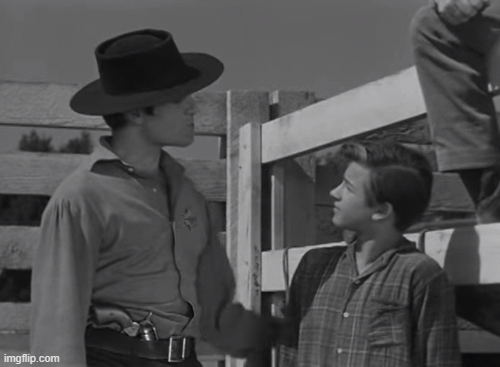
There’s a link to the episode below but if you’re disappointed with the brevity of Master Erikson’s spanking, don’t worry, he’ll be back on the blog soon over Bob Hope’s knee (still aged 14).
youtube
12 notes
·
View notes
Text

#paraportal#paracosm#immersive daydreaming#artorbis#epnona the wisp#sarah rose#remjo#marko of kridraco#avel#wolke#leif#violet#aster#sivert erikson#pietro of kridraco#twill the shadow imp#kira of rangelvie#sage#princess irene#lucas of greydawn#daven#shleaema#elden#fayim#inyis#kaelum#akua#tera#aster of kridraco
26 notes
·
View notes
Text
The greatest gift of education is the years of shelter provided when learning. Do not think to reduce that learning to facts and the utterances of presumed sages. Much of what one learns in that time is in the sphere of concord, the ways of society, the proprieties of behaviour and thought... This is another hard-won achievement of civilization: the time and safe environment in which to learn how to live. When this is destroyed, undermined or discounted, then that civilization is in trouble.
— Steven Erikson, Forge of Darkness (The Kharkanas Trilogy #1)
14 notes
·
View notes
Text
Blog Entry #7: Ghosts of The Past
In this entry, I discerned new realizations about me and my mother’s upbringing and how these influenced my growth and development as an individual. Some influences are necessary and some are not. Yet all of these factors made me the person I am now.
First, the realizations start with how my mother was influenced by her parental figure and how that affected my upbringing. How these were mere products of continuous intergenerational factors were discussed next. Lastly, these discoveries were used to analyze how my stages of development as a person were affected by these influences.
The Mother’s Influence
Seeing my primary parental figure in life, which is my mom, in her perspective as a child once was challenging and eye-opening. It is difficult, at first, to investigate my mom’s history as it is a sensitive topic for the reason that she lost her mother during her teenage years.
Still, I decided to ask her about her most memorable story as a child. She started by telling me how strict and punitive her mother was to the point that she was wary of making a single mistake in every order that my grandmother gave to her then. She was raised conservatively considering that she was raised during the 1970s when life was harsher for women compared to the present. According to her, she was often scolded and punished by having her kneel on salt for minutes whenever she had done something unacceptable. My grandmother was still caring and loving though, as my mom defends. Most importantly, she told me how this formation taught her to be strong and that it was consequential for her growth as the firstborn.
Seeing how she rationalized my grandmom’s stern upbringing to her, I can see now why she kept the same for us, me and my siblings. It is because in her mind, what my grandmother did for her was right and justified. Nonetheless, she lessened the disciplinary actions for us compared to what she experienced then as she didn’t want us to have marking memories of pain from her. Yet, she kept her conservative values in raising us and I am thankful for that.
In the end, it affected me less relative to my grandmom’s influence on my mother. I and my siblings know how sometimes rigid behavior is warranted from our parent and how it gave us a solid moral code what we ought to and ought not to do.
Intergenerational Patterns
One of the family’s ongoing intergenerational pattern on both sides is piety and passionate dedication to our religion. I easily recognized this trait as I’ve observed how my mother stresses how God has been generous for our lives and the lives of her ancestors. Hence, we currently go to church twice each week consistently as fervent members of the Iglesia ni Cristo. More than that, all of us in the family hold significant church duties which we accomplish every week.
I look at this devotion to faith as an integral part of my life since I was a child. This trait built my commitment and conscience as an individual and my gratefulness in life. It is helpful to our family’s nurturing of values as a whole. To keep these virtues going through the next generation, I can continue the same beliefs and pass them on to my future children (if ever there may be). It might be convenient to keep our family friends in the same religion in close contact to have a surrounding community of avid church members around the family to be good influences. Through this, good qualities like compassion, generosity, and hospitality can be further fostered alongside piety as the family’s intergenerational attributes.
On the other hand, our family held strong disbelief against politics. My family, down to my grandparents, were not as involved in political concerns of the country. More than that, our current religion doesn’t give us the liberty to be opinionated on these matters. I find this characteristic to be harmful to the family’s ideals because this limits our involvement with the state of the nation. As citizens of the Philippines, I believe that we should have been responsible for the development of the nation. To change it, I consider leaving our current religion in the future as it is the primary factor why we stay apolitical.
Personal Growth and Development
When I ask my mother about a childhood story, she told me that I was a quiet child who never played outside. I never really played games with other children and that I stayed at home most of the time when I was young. My same age classmates in preschool then weren’t social or interactive with me at school as I was snobbish and dismissive back then to other kids.
Considering how this past is a stark contrast of how social I am with people, I think that this tendency to isolate myself from peers didn’t affect me as much as my mother thought it would. This is in line with Erikson's Stages of Development. During preschool, I would have been in the initiative vs guilt stage and my aloofness would have had an effect on my sense of purpose or responsibility. I think in the present, I have a good sense of both. However, I recognize how I still acquired a little of the negative outcome from this stage as I tend to be inhibited by myself in opening up my real self to people. But when it comes to working environments, I could easily lend some help.
Going back to the first stage of Erikson's Stages of Development, trust vs mistrust, I would say that I am leaning more towards distrust. In a scale, it would be a score of 4 on the negative side. I wouldn’t know the reason why since I was just an infant then but I am a skeptic college student. I don’t believe hearsays and other people easily as I tend to be disappointed by my expectations of them. I still have hope and security but I always keep a doubtful stance on everything, unless confirmed by myself.
To the second stage, autonomy vs shame and doubt, I would say that I have a score of 8 which leans on the positive side. Considering the outcome, I would say that I was not restricted by my parents when I was a toddler in directing my actions. This great self-determination that I have now is the result of the development in this stage. Still, I think I wouldn’t have a perfect score of 10 as I tend to be doubtful of myself sometimes especially when doing things that I haven’t done before.
The third stage, initiative vs guilt, is as explained previously. I think I would have a score of 7 on the syntonic side. This is because I was a reserved toddler who rarely socialized then. But in school, I have a great initiative in working on school activities not just in forming bonds with my classmates then. Now, I developed a solid sense of responsibility in areas of labor but I am slow to open up myself to other people.
I would say that I have a really positive fourth stage of development, industry vs inferiority, with a personal score of 9, leaning on competence. When I was in grade school, I participated in a lot of competitions and won most of them. This developed my self-efficacy as a child. I achieved multiple recognitions at that age that I am sure of what I can do in school and as a person. This also inspired me to take on a difficult career in the future which is being a physician and surgeon.
Now in the sage of identity vs role confusion, I would give myself a score of 7. At first, I thought that I am spreading myself to thin by easily getting along with people of different backgrounds. However, as time passed, I realized that I am not changing myself for others and this amiable characteristic is an innate trait of mine which is not affected by the people I interact with. I now am confident with my position among my peers, with what I believe in as a person, and with the occupation that I am pursuing. With these, I would assume that I am close to solidifying my identity that’s why I give myself a syntonic score.
With all these realizations, I am now seeing myself in another light aside from introspection. With the help of our family’s history and my personal upbringing, I am able to confirm my development as a person influenced by all these said factors.
2 notes
·
View notes
Photo

http://surfandbefree.tumblr.com
Sage Erikson
ph. Alana Spencer
#sage erickson#surfer#pro surfer#surf girl#surfer girl#surf#surfing#summer#beach girl#bikini#surfboard#surf blog#tropical#RVCA
307 notes
·
View notes
Link
Dora holds an historic place in the transition in Freud’s thinking regarding psychosexual development in general, and away from a constructive curiosity about female development that seemed to have been piqued by or at least survived the abandonment of the seduction theory in 1897, heralding the role of fantasy in inner life. Dora was analyzed in 1899, but the case’s publication date (1905) is also the date of Freud’s unrevised first edition of Three Essays. Not until 1908, three years after Dora was published, did he add his theory of ubiquitous penis envy to the description of girls’ development. (His famously male view of girls was not incorporated in Three Essays until its third revision, in 1915.) His 1908 “On the Sexual Theories of Children” included what turned out to be “bedrock” comments about his one-sex male theory for girls. However, at the time of Dora, Freud had developed only a partial and simplified oedipal theory that concerned whole persons in the family rather than part objects or body parts. The early oedipal situation held that a girl would normally turn sexually to the father, as would the boy to the mother. The female genitals were still viewed as whole and female. He had noted in correspondence with Fliess that a girl could envy a penis because she wanted everything; that is, in this iteration of Oedipus, she is left in basic possession of her own genitals, with the penis an added fantasy organ. With Dora, as in The Interpretation of Dreams, he expected a female to have sexual pleasure, and did not confine that asset solely to the penis, as he would later.4 He also recognized bisexuality as a part of the human condition, meaning that under certain psychological conditions Dora could be sexually attracted toward either a man or a woman.
However, the stage was being set simultaneously in 1905 for a wrong turn (Balsam 2015a). Though real female sexual pleasure and the pleasures of procreation were seen as expectable, this came at a price. Freud’s view of how the woman should handle these pleasures was problematic. She was not supposed to exercise her own autonomy. A woman may be symbolized in dreams by “the house,” but sexually she was not mistress in her own house! The master owned that house. Sociopolitically, Dora was ahead of Freud in this respect, and rebelled against this oppression. Blum (1994) has commented on her Jewish identity in this regard, remarking that as both a woman and a Jew she was in a societally oppressed position. Erikson (1962) noted Dora’s looking to Freud for validation of the reality of her complaints against the grownups, and he affirmed her mental health in this regard. But of course Freud’s theory of her denial and negation of healthy, expectable genital pleasures, in his view due to her unfair rage at the much older, married Herr K.’s arousal toward her, invalidated both her autonomy and her aggression in response to this actual sexual harassment. Erikson thought this undermined her identity formation. Freud got it half right. He valuably saw Dora’s body as whole and healthy in its expectable capacity for sexual arousal and responsiveness (a feature that the later theory of a male-sexed libido “phallic phase” theory would undermine). He wanted Dora to own her own body as a woman. However, seeing Herr K. in any negative light, or her father, or his own cigar-smoking self as a focus of negative transference to a woman was hard for him. Freud had not yet met Karen Horney, and in any case, when he finally did he greeted her insights with hostility. She might have suggested that Dora’s fear, horror, and disgust when exposed to Herr K.’s or her father’s sexuality may have been influenced by her reactions and fantasies regarding the disparity between the size of the man’s erect penis and her sense of the smallness of her vagina, or that her rage may have been due to wounded disappointment in her love for her father. Freud neither imagined nor took kindly to such ideas.
Freud’s Body Work with Dora
In his body work with Dora, Freud is direct and free. He uses the dream image in her second dream of the train station and woods, and her association to nymphs playing, to elaborate elegantly on the “symbolic geography of sex” (Freud 1905a, p. 99). He received and translated Dora’s vaginal references: the “forecourt” of the vulva; nymphae as a reference to the labia minorae with pubic hair behind, as in a wood; her fantasy of defloration; and the big book she read in at the dream’s close as likely an encyclopedia where she was looking up details of sex, pregnancy, and childbirth. Marian Tolpin (2004) wrote admiringly about Freud’s poetic symbolic understanding of Dora’s female organs. Other images of Dora’s body were the “reticule” (purse) she wore at her waist as a vaginal symbol, and the “room” (“apartment”) she wanted to lock at night that also represented her vagina. Further, her associations to the “closed” door of her “room” represented being closed to intercourse, while a door “opened” by a key meant being open to the penis in intercourse. “All these,” Tolpin notes, are described by Freud as “‘once again only a substitute for the shell of Venus, for the female genitals’ (1905a, p. 77). What more compelling and appreciative symbol of feminine beauty and desirability (in general) or of female anatomy (in particular) could Freud evoke than the famed Botticelli Birth of Venus and the lustrous shell on which the goddess of love is artfully enthroned as she is born from the sea? What more powerful ‘mirroring’ affirmation of a woman’s anatomy and sexuality could a psychoanalytic theory provide?” (p. 172). Tolpin thought it not surprising that these transient “early affirmative views have been virtually obscured by Freud’s ‘relentless investigation’ [Marcus 1990, p. 85] of Dora’s sexuality.” Freud’s critics, she believed, have conflated “his later castration theory of women’s genital injury, mortification, penis envy, and hostility with his earlier theory of the purse as female genital and the wish for intercourse with Herr K. which Dora angrily rejected” (p. 172). Tolpin’s observations are well taken.
1 note
·
View note
Photo
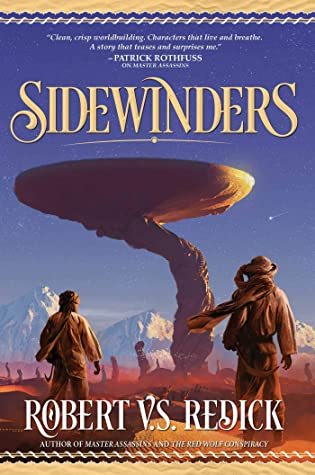
REVIEW: Sidewinders by Robert V.S. Redick
June 28, 2021
By Julia Frazer
Sidewinders by Robert V.S. Redick is an ambitious, impressive novel that rightfully takes its place within the halls of classic desert fantasy. Sidewinders, which will be released on July 6, 2021, is the second novel in a planned trilogy called The Fire Sacraments. Grimdark Magazine received an ARC of Sidewinders in exchange for an honest review.
After the murder of the Prophet’s favorite son in a case of mistaken identity, brothers Kandri and Mektu Hinjuman have become two of the most infamous people alive in war-ravaged Urrath. Kandri and Mektu attempt to escape the Prophet’s immense force of religious fanatics, facing hardship and avoiding death at every turn. This review contains mild spoilers for the first installment, Master Assassins, which should be read before Sidewinders.
“We have just entered the desert, this great killer who dispatches even the best of us, the most sage and seasoned, indifferent as the rag that wipes the soot from the kettle. Now you appear and we must accept you, share our camels and our water and our way. They are rationed, life is rationed, why should we die that you might live?”
Sidewinders begins right where Master Assassins leaves off as the brothers Hinjuman travel with a caravan across the deadly deserts of Urrath. They must not only flee their hunters but also deliver a letter with earthshattering repercussions regarding a lethal disease that has plagued the world for generations. As the brothers traverse the arduous desert roads to the purported safety of the fortress city of Kasralys, disaster upon disaster befalls them. However, the vast desert is only one of their most dangerous foes. Some of their fellow travelers also covertly seek the brothers’ demise. A bejeweled weapon is coveted by all and brings ruin to any who carry it. And unconquerable Kasralys might be about to face its most dangerous opponent yet.
New characters are introduced as the plot expands from a heart-pounding chase through the desert to complex political intrigues, but the brothers Hinjuman still take center stage. Kandri’s point of view occupies the majority of the novel. In addition to a few new third-person limited perspectives scattered throughout Urrath, there are some interesting first-person interludes to add variety and insight to Kandri’s journey and the mythology of the world.
Redick’s world-building is top-notch. Sensory details are excellent, and the author makes the desert into its own character. Anything other than devouring Redick’s fantastic prose for yourself is inadequate to describe just how concrete his world feels. Realistic details of the difficulties of survival in the desert contrast fantastical elements like the horrifying sky jellies, large jellyfish-like creatures that nest in the desert and can envelop a man and dissolve him alive.
“The wise brother undone by the idiot, the idiot saying what no one else dares to say. And the madman, the believer in he knows not what: flailing, falling, drawn to death like a salt lick […] I don’t like human beings. And I’ll ask you not to judge me unless you’ve done as I’ve done. Unless you’ve lived among them, worn their skin, dwelt in their sternums, felt the constant stabbing signals that race from brain to stomach to fingertips, listened to the gurgling advance of waste gasses down the coiled tubes in their abdomens, learned their names, sipped their terrors, attempted that bludgeoning exchange they call communicating, glimpsed the lake of fire they call love.”
Redick has undeniably evolved as a writer and storyteller since his Chathrand Voyage series. The Fire Sacraments is very firmly in the adult grimdark category, while Chathrand Voyage is more lighthearted YA. So great are the differences in prose, character, setting, and intended audience that The Fire Sacraments series almost feels like it could have been written by an entirely different author than Chathrand Voyage.
Sidewinders is a lyrical, feverish novel that requires the reader to slow down, take a break, and jump back in. A binge-read doesn’t necessarily allow for the necessary time and space to absorb the well-plotted tragedy and terrific prose. Redick deftly sidesteps expectations and takes the story in unexpected directions while still honoring the desert fantasy genre. Redick’s writing in Sidewinders often reads more like a prose poem than a novel. His word choice is precise, and his sentence construction is effective in its turns of stuttering, rambling, and flowing smoothly.
“He caught the sword of the next rider with the flat of his blade and let his arm give way until both hilts were near his face and then seized the other’s wrist in his teeth and bit down grinding through veins until he choked on blood and there was another dead man, another soul to taste and swallow and forget.”
Interestingly, Redick switches from using the present tense in the first novel to the more standard past tense in the second novel. Redick reveals his thinking in Grimdark Magazine’s incoming interview with him. Readers may forecast a clever structural reason like N.K. Jemisin’s Broken Earth trilogy, which had the unconventional use of the second person that only makes sense in the context of the entire trilogy.
Redick capably manipulates the reader’s emotions throughout Sidewinders. As the characters get deeper into the desert, their descent into madness continues. Redick’s prose allows the reader to experience some measure of that same madness with hypnotic depictions of dreams, nightmares, and the cascading dominoes of chance versus destiny. Sidewinders also has a rare exploration of the structural injustice of the healthcare industry not often portrayed in high fantasy that will resonate for audiences like the U.S. without universal healthcare. Redick discusses this concept in detail in Grimdark Magazine’s recent interview.
Through effective use of the device of the desert as a catalyst, Redick reveals the dark and bright facets of human nature that arise when the trappings of civilization are stripped away by the desert. So too does the desert help reveal universal feelings of loneliness and the idea that one human can never truly know another. His depictions of familial squabbles and the heavy burdens of becoming a caretaker for a loved one feel grounded and authentic.
Fans of Steven Erikson and Bradley Beaulieu will appreciate the elaborate world-building and expansive plots of Robert V.S. Redick. With its well-researched anthropology and devastating conclusions, Redick’s series also feels emotionally similar to that of Mary Doria Russell’s The Sparrow. Sidewinders is a beautiful fever-dream of a novel that is bound to impress. Redick has outdone himself with this second installment, and no doubt the third novel will continue to surpass and subvert expectations.
1 note
·
View note
Text
Stage Set for US Open of Surfing Huntington Beach pres. by Shiseido
Stage Set for US Open of Surfing Huntington Beach pres. by Shiseido
Pictured: Reigning US Open of Surfing victor Sage Erickson (USA) is back to defend her title. Credit: © WSL/ Kenny Morris
Some of the World’s Best Men and Women Descend Upon Surf City USAReigning Event Winner Erikson Ready to Defend Her TitleHometown Hero Igarashi Returns in Search of Historic Third US Open WinMore Available at WorldSurfLeague.com
The stage is set and some of the world’s best…

View On WordPress
0 notes
Photo

6 notes
·
View notes
Text
Tracking my “series to read one day, just not today”
Authors who have written a lot (as in “I do want to read them but where do I even start ? Should I read them in a row ?”)
Lois McMaster BUJOLD
Vorkosigan Saga (7/31)
I feel like I need to reread from the start to be able to continue.
Bothari is something. Miles is one of the few disabled characters I’ve read and it was really upbeating to have him. Pure enjoyment.
C. J. Cherryh
I wanted some old science-fiction by female writers (thanks to The Left Hand of Darkness)
Anything by her is fine.
Glenn COOK
The Black Company (0/10)
I like my fantasy to be gritty. With adult protagonists.
Steven ERIKSON
Malazan Book of the Fallen (1/10)
Read and liked Gardens of the Moon. I wanted to read all of them before leaving some place, turns out that I really overestimated my ability to read. Furthermore, I would need to reread this volume and it is long. Postponing and postponing until I have both the time and a lasting ability to read. Requires a lot of commitment and raises the question of “how do you read a long series without forgetting anything in-between two volumes ?”.
Robin HOBB
What is happening with the Fool ?!
The Realm of the Elderlings (read the first few chapters long ago)
The Farseer Trilogy (0/3)
Liveship Traders Trilogy (0/3)
The Tawny Man Trilogy (0/3)
The Rain Wild Chronicles (0/4)
The Fitz and the Fool Trilogy (0/3)
Katharine KERR
Deverry Cycle (0/15)
Dunno. She appears too often in my brain for me to let her go.
Katherine KURTZ
Fantasy from the 70s ? By a female writer ? Checked ! Classical fantasy without it being a young girl bullied, I am in.
The Chronicles of the Deryni (0/3)
The Legends of Camber of Culdi (0/3)
The Histories of King Kelson (0/3)
The Heirs of Saint Camber (0/3)
King Kelson's Bride (0/3)
The Childe Morgan Trilogy (0/3)
Marcel PROUST
In Search of Lost Time (0/15)
For reasons I’ve since quite forgotten.
Rick RIORDAN
Percy Jackson & the Olympians (at least two volumes read) (2 ? /5)
The Heroes of Olympus (0/5)
The Kane Chronicles (0/3)
Magnus Chase and the Gods of Asgard (0/3)
Somehow, it seems possible to read all of their series ... but I can wait
C. S. FORESTER
Horation Hornblower (0/15)
Watched one movie. Historical and maritime. Not something I am used to : “let’s try it”.
Cornelia FUNKE
Inkheart trilogy (0/3)
I swear I do read more “recent” books.
Ursula K. LE GUIN
Earthsea (0/6)
I’ve discovered Le Guin with her science-fiction. I like the idea of a young Ged wandering around, though.
Karin LOWACHEE
Warchild, Burndive, Cagebird (1/3)
I unexpectedly found Warchild at the library. I didn’t remember why I wanted to read it (surprising ?) but borrowed it nonetheless. To this day, I still don’t know how to feel about it but this one made me sad.
Angie SAGE
Septimus Heap (0/7)
One of those series I missed when I was younger. (Before Twilight took over).
Jonathan STROUD
Bartimaeus Sequence (0/3 + 0/1)
Had to return the first volume before completing it.
Lockwood & Co. (2/5)
Nice likeable characters. Really enjoyable but not enough for me to actively search for the following books, and even more so when I am down.
J. R. R. TOLKIEN
The Lord of the Rings (something like 5/1000+ pages ?)
Technically not a trilogy but long enough to know that I might struggle to get through it.
May finish The Silmarillion way before tackling the series.
Tad WILLIAMS
Memory, Sorrow & Thorn (0/3)
I like to read some “old” finished stuff, what can I say more ?
Roger ZELAZNY
Chronicles of Amber (0/10)
Doesn’t seem that long. Old series, as usual, there is a chance I might be in.
I am on my way (like possibly reading it in the next ten years)
Lynn FLEWELLING
Tamír Triad
The Nightrunner Series
Both of them.
Diana Wynne JONES
Howl's Moving Castle series (1/3)
A pain to find her books in libraries and bookshops unless I buy them on the net. I do have two out of the three books in this series. And Howl’s Moving Castle is one of the few books I’ve reread and plan to reread again.
Ursula K. LE GUIN
Hainish Cycle (1/8)
I used to be less interested in science-fiction before but The Left Hand of Darkness was a slap in the face to say the least. Still not over it, it has been too long, already. A bit afraid to be disappointed in her other works (but I won’t, right ?).
Mary RENAULT
Alexander novels (0/3)
It’s either that or her Arthurian novels. I have a (weird ?) interest in Alexander the Great. This guy thought on a grand scale. Died young. Truly sad.
Dan SIMMONS
Hyperion Cantos (0/4)
I stop everytime after the priest story. Every single time.
Rosemary SUTCLIFF
The Eagle of the Ninth (1/8)
Read The Eagle of the Ninth a year ago, perhaps more, and I regularly crave for a reread.
Other series worth mentioning (quite often those ones from the 1980s-1990s, r/fantasy is often to be blamed)
Bernard CORNWELL, Stephen R. LAWHEAD, Mary STEWART and Jack WHYTE
King Arthur.
Dorothy DUNNET
Lymond Chronicles (0/6)
I do like historical novels, even though I rarely read them. Perhaps was recommended because of Guy Gavriel Kay and prose ?
Jennifer FALLON
The Wolfblade Trilogy (0/3)
I have no idea why. Perhaps romance (?) and politics ?
Robert JORDAN (0/15)
The Wheel of Time series (0/15)
Once saw a fanart of Rand. It’s enough for me to begin a series. However, I am afraid that the depiction of women will leave me with a sour taste. Also, I don’t really like Brandon Sanderson (Way of Kings was just a nightmare to finish).
Juliet MARILLIER
The Sevenwaters Trilogy (0/6)
Yep, right, trilogy. Retelling of a tale. Why not.
Sarah MONETTE
Doctrine of Labyrinths series (0/4)
???
Michael NAVA
Henry Rios novels (0/8)
I rarely read crime novels. I did found about these books at a specific time so I am very fond of these novels.
Melanie RAWN
Dragon Prince (0/3)
I don’t even know. Female author. Forgotten one ? Old one that nobody around me knows about.
5 notes
·
View notes
Note
Do you have any book series you really want to start reading? Do you have any series that you want to finish?
Thanks for the ask :D
There are three series I really want to start, but I haven’t dared yet because they’re all quite long and “classic” fantasy and I’m a bit scared of disappointment. Theses are: Sword of truth by Terry Goodkind, the Wheel of Time by Robert Jordan, and The Malazan Book of the fallen by Steven Erikson.
There are way more series I want to finish! The witcher by Andrzej Sapkowski (3 books to go), Septimus Heap by Angie Sage (5 and a half books to go), Discworld by Terry Pratchett (uuuh I don’t want to count but probably 30 something to go), and these are just of the top of my mind lol
2 notes
·
View notes
Text
Reference List
Barker, C 2012, Cultural Studies: theory and practice, 4th ed, Sage, London, pp. 218-225.
Bennet, A, Royle, N 2016, An Introduction to Literatur, Criticism and Theory, 5th edn, Routledge, New York, p. 151.
Brooks, P 2001, Troubling Confessions: Speaking Guilt in Law and Literature, University of Chicago Press, Chicago, p. 9.
Eidrigevicius, S 1992, Red Roses, photograph and collage, postcard from my collection.
Erikson, E 1968, Identity, Youth and Crisis, Norton, New York, p. 38.
Fiske, B 1902, Rain in the Face, photograph of Hunkpapa Sioux warrior, postcard from collection.
Hall, S 1992b, The Question of Cultural Identity, Hall S, Held D, McGrew T (eds) Modernity and its Futures, Polity Press, Cambridge, pp. 275-277.
Hall, S, Held, D, Hubert D, Thompson, K 1996, Modernity: an introduction to modern societies, Blackwell Publishers, Oxford, p. 597.
Howes, D 2005, Skinscapes: embodiment, culture and environment, in Classen, C, The Book of Touch, Berg, Oxford, pp. 27-39.
Mansfield, N 2000, Subjectivity: theories of the self from Freud to Haraway, Allen & Unwin, St Leonards, NSW, pp. 13-29.
McGarry, L 2017, Freudian Slip, Instagram, viewed 23 March, 2019, https://www.instagram.com/p/BWOcx5jl_b6
Nietzsche, F 1908, Ecce Homo, translation by Hollingdale, R 1979, Penguin Books, New York, p. 88.
Photographer unknown, 2019, Retford Park, Bowral, ric_ abel, Instagram, viewed 23 March 2019, https://www.instagram.com/p/BuPdr4oFN8h/
Schiele, E 1918, Woman Sitting with Left Leg Drawn Up, water colour and pencil on gouache, postcard from my collection.
Scott, R 1975, Ghost Train, gelatin silver photograph, 304 x 456mm, postcard from collection.
Whitey, C 2018, Kerby Brown in Western Australia, image, Instagram, viewed 23 March 2019, https://instagram.com/p/Bpde7Z2hg4nf/
Whiteley, B 1976, Self Portrait in the Studio, oil and collage on canvas, 2005 x 2059mm, postcard from collection.
Winton T, author quote, goodreads, viewed 20 March 2019, https://www.goodreads.com/author/quotes/19929.Tim_Winton
Wright, A 1995, Vibe Tribe, gelatin silver photograph, 300 x 300mm, print from collection.
Wright, A 1995, The Artist in his Skin, polaroid photograph, print from my collection.
Wright, A 2018, The Wrights at Wongwibinda, Hipstamatic photograph from my collection.
Wright, A 1991, Alison and Lindsay, silver gelatin photograph, 300 x 300mm, print from my collection.
Wright, A 1994, Forest Festival, Tasmania, silver gelatin photograph, 300 x 300mm, print from my collection.
Wright, A 2012, Jasper in Tie-Dye, colour photograph from my collection.
0 notes
Text
Deep Caring XXIX: Generativity Four— Generativity or Stagnation?
Deep Caring XXIX: Generativity Four— Generativity or Stagnation?
William Bergquist and Gary Quehl
We conclude our exploration of civic engagement and Generativity Four by turning once again to the fundamental choice that Erik Erikson first identified when describing the stages of adult development: generativity or stagnation? Virtually all our Senior Sages know persons in the community who possess sage leadership qualities but are far removed from being…

View On WordPress
0 notes
Text
Laina Villeneuve on how “Kat’s Nine Lives” cover art reveals much about the characters and the author too
You’ve heard the saying “don’t judge a book by its cover.” I’d like to take the opportunity, if I may, to do just that. My sister and I found, without too much trouble, an image that matched a scene from the book, and Bella pulled together a cover for Kat’s Nine Lives that pleased us both immensely. I am grateful to have a cover I feel proud to show off, and once the book came out, I printed a copy and taped it to the window on my office door.
A colleague stopped to congratulate me on the book. He’s old school, a sage on the stage, and in my office door, he struck his lecturer pose and said he appreciated the symbol of the flame, imagining that love burned brightly for my two characters. Leaning closer, he said, “but I see that one is more sure of herself.” I gladly played along with his symbol analysis, supplying that Kat’s sexuality has, indeed, wavered over the years while Wendy has always been steadfast in hers.
“And love is center stage.” He pointed to the red flower-shaped candle floating. “And the wind blowing from the east, signifying…” He prompted me, and I tried to think of something sufficiently intellectual. The yellow candle caught my eye. “Yellow symbolizes friendship. Note how it is moving aside to let love blossom between Kat and Wendy.”
He tapped the door frame with a wide smile of appreciation for my tying the flowers to the act of blooming. He bowed and continued down the hall, and the exchange has flitted around in my mind ever since. Surely the pink flower must mean something as well. I turned to Google and was surprised to find that pink is actually the color associated with romance, not red. Red signifies life, vitality, passion, and fire. Well, the issue of life is tied to the title, and Kat is certainly vital and passionate, though she has spent much of her life dampening that fire.
And the blue of the cover? I’m glad you asked because Google says it reflects depth and stability, qualities Wendy certainly brings to Kat’s life. With Wendy’s help, over the course of the novel, Kat finds her true self. She resolves her role confusion in order to find her identity. But now I’ve shifted from formal criticism to Erik Erikson’s social development theory. Perhaps a doorway conversation for another time… Thanks for stopping to chat. http://dlvr.it/R2CPZ0
0 notes
